
The Rearguard at Bobr, 1812
19th January 2023, 2 Comments
The Napoleonic Wars, Black Powder, 28mm
We wanted a simple but challenging game this week, so I delved into Grant & Asquith’s “Scenarios for all Ages” for inspiration. They had one that was perfect: “A Vital Bridgehead”. In our version, the French were trying to get across the Bobr River, while engineers were rigging the Bobr bridge with charges. The rearguard had to hold off a larger force of Russian pursuers until everyone was safely over it. In this game, set in late November at the height of the retreat, the French have a small mixed brigade of five units plus some guns. They have to to buy time for the wagons and stragglers to make it over the bridge. They have ten straggler “units” to get over, and the bridge can only hold one unit each turn.
In this game, set in late November at the height of the retreat, the French have a small mixed brigade of five units plus some guns. They have to to buy time for the wagons and stragglers to make it over the bridge. They have ten straggler “units” to get over, and the bridge can only hold one unit each turn. 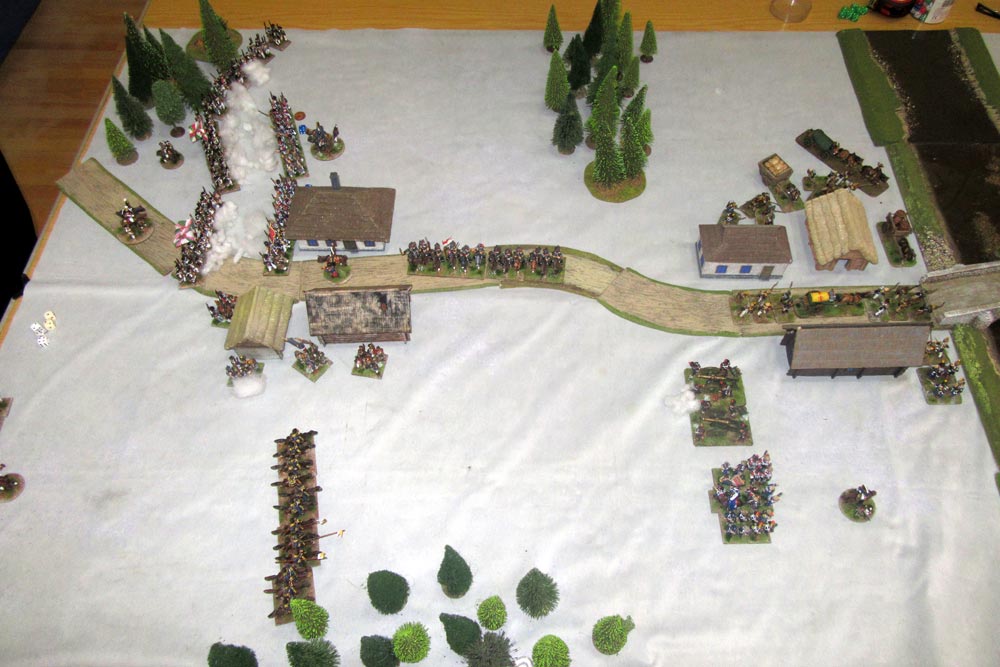 Nick and Sean 1 played the French, Sean 2 and I commanded the Russians, and we played on a white-clad 6×4 foot table. The French defenders had to split their forces, with 2/3 in B1, and the rest, plus the wagons and stragglers in B2. They also had a unit of engineers on the ridge. The Russians came on – three units a turn – on the eastern table edge.
Nick and Sean 1 played the French, Sean 2 and I commanded the Russians, and we played on a white-clad 6×4 foot table. The French defenders had to split their forces, with 2/3 in B1, and the rest, plus the wagons and stragglers in B2. They also had a unit of engineers on the ridge. The Russians came on – three units a turn – on the eastern table edge. 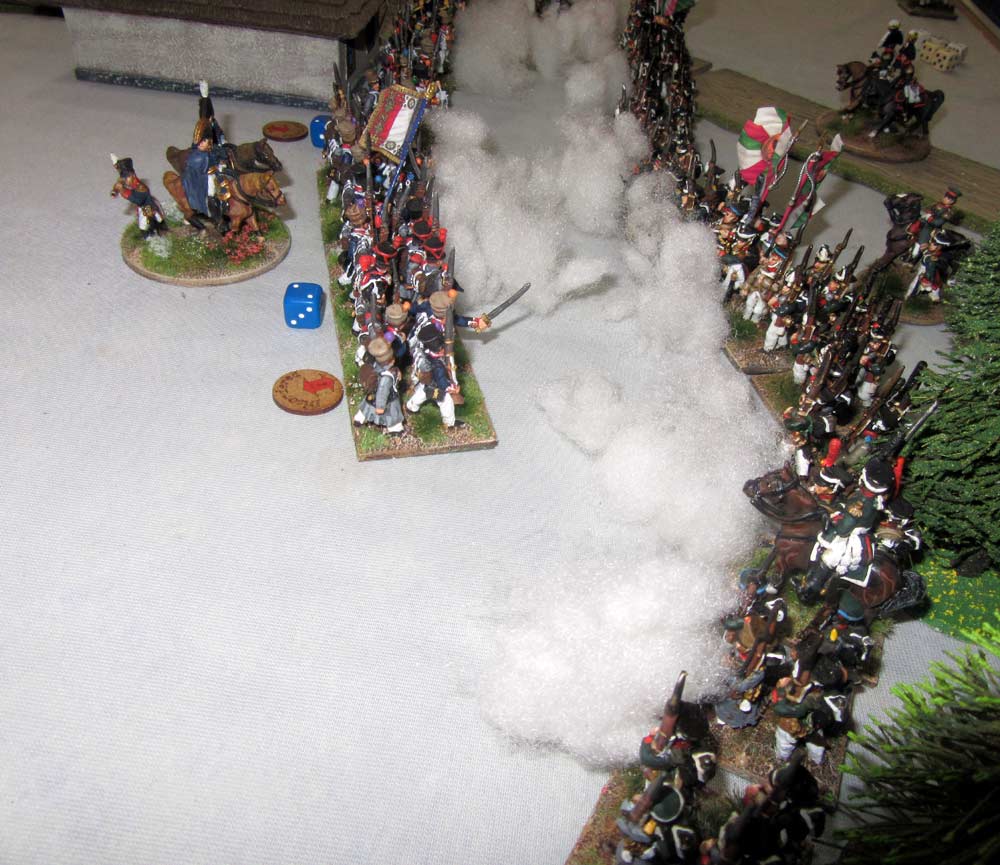 The Russian advance guard was made up of a mixed force of two infantry battalions and a hussar regiment. When they came on the infantry were sucked into a close-range firefight at the first hamlet, held by two battalions of French infantry. Meanwhile on the bridge the engineers worked away on setting charges, and the first units of wagons and stragglers made it safely across.
The Russian advance guard was made up of a mixed force of two infantry battalions and a hussar regiment. When they came on the infantry were sucked into a close-range firefight at the first hamlet, held by two battalions of French infantry. Meanwhile on the bridge the engineers worked away on setting charges, and the first units of wagons and stragglers made it safely across.  The next turn, the Russians brought up a jaeger battalion, a gun battery and another hussar regiment. Things were hotting up, but the French performed well, holding their ground against superior numbers. It was inevitable though, that they’d eventually be forced back. the French judged it well though, holding the hamlet for four turns before withdrawing to the west.
The next turn, the Russians brought up a jaeger battalion, a gun battery and another hussar regiment. Things were hotting up, but the French performed well, holding their ground against superior numbers. It was inevitable though, that they’d eventually be forced back. the French judged it well though, holding the hamlet for four turns before withdrawing to the west.  Over on the bridge the evacuation continued, and the defenders of the riverside hamlet now got into action. The French guns disordered the Russian Marioupol hussars, who were already shot up a bit by the defenders of B1, and a timely charge by the Hessian chevaulegeres drove them back. The Russians though, now brought up Cossacks, another gun battery, and yet more infantry.
Over on the bridge the evacuation continued, and the defenders of the riverside hamlet now got into action. The French guns disordered the Russian Marioupol hussars, who were already shot up a bit by the defenders of B1, and a timely charge by the Hessian chevaulegeres drove them back. The Russians though, now brought up Cossacks, another gun battery, and yet more infantry.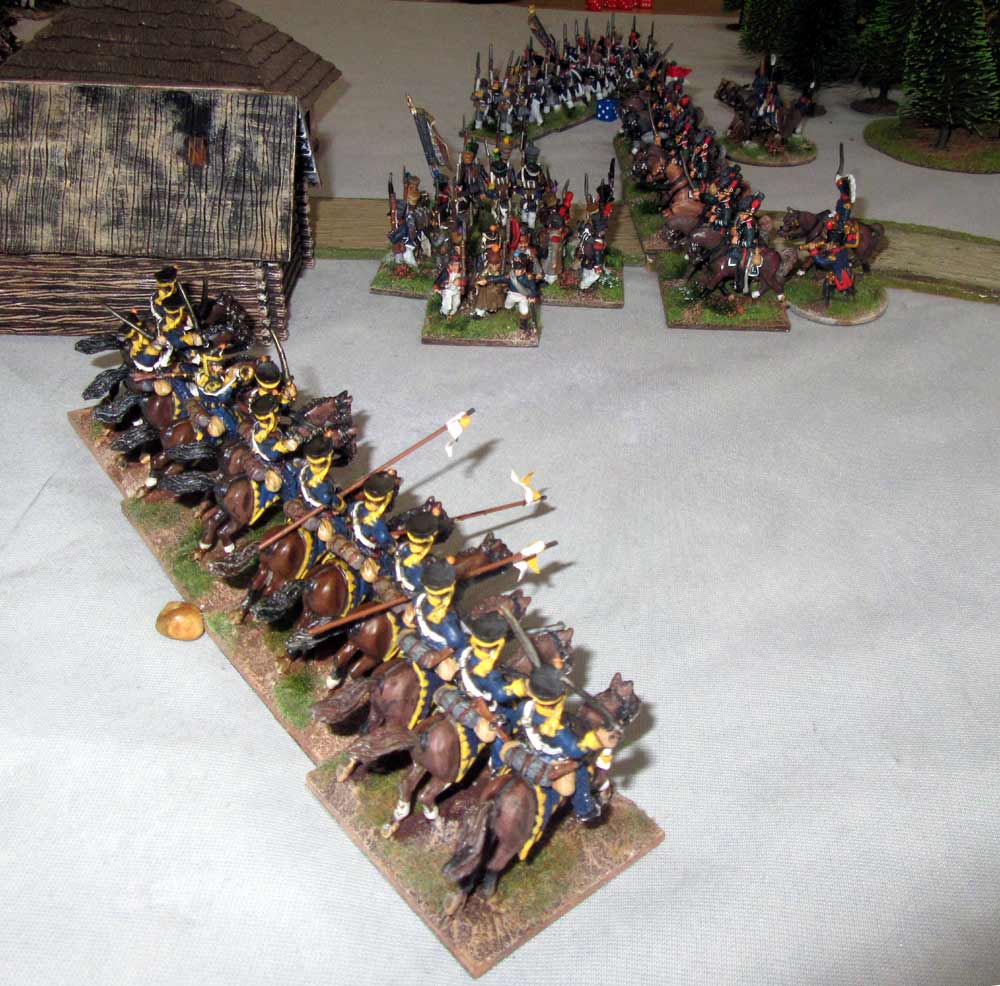 The battle now was all about cracking the defenders before the last of the wagons and stragglers reached safety. The Russians were really piling on the pressure now, but so far the French line was holding, and the last of the wagons and stragglers were crossing the bridge.
The battle now was all about cracking the defenders before the last of the wagons and stragglers reached safety. The Russians were really piling on the pressure now, but so far the French line was holding, and the last of the wagons and stragglers were crossing the bridge.  Over to the south of B2 the Cossacks and jaegers tried to loop around the flank of the defenders, but a dense wood (a hill in the original scenario map) blocked the way. So instead they pressured a battalion of French light infantry, holding the defender’s right flank. The pressure was piling onto the French left too, thanks to the Russian guns brought up to form a massed battery.
Over to the south of B2 the Cossacks and jaegers tried to loop around the flank of the defenders, but a dense wood (a hill in the original scenario map) blocked the way. So instead they pressured a battalion of French light infantry, holding the defender’s right flank. The pressure was piling onto the French left too, thanks to the Russian guns brought up to form a massed battery. 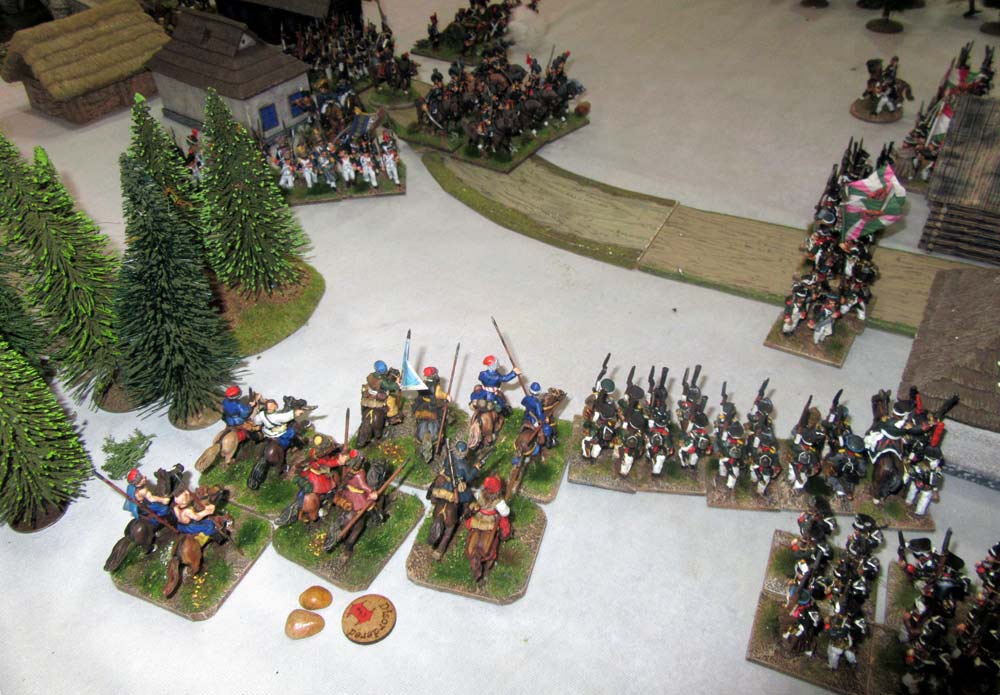 On the Russian left the Cossacks failed to charge home, but with all three French battalions in square, it was hard for them to hold back the Russian infantry. On the right the red-coated Russian hussars – Izyumski I think – charged the guns, but took too many hits going in, and were disordered and shaken. So, they had to retreat. Still, the French were now suffering hits, and looking fragile.
On the Russian left the Cossacks failed to charge home, but with all three French battalions in square, it was hard for them to hold back the Russian infantry. On the right the red-coated Russian hussars – Izyumski I think – charged the guns, but took too many hits going in, and were disordered and shaken. So, they had to retreat. Still, the French were now suffering hits, and looking fragile.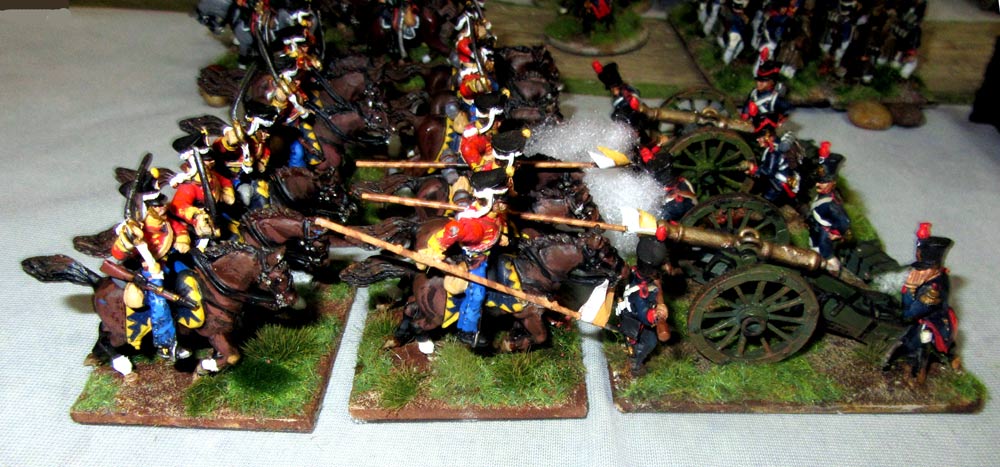 Somehow though, they held, allowing the last of the wagons and stragglers to reach the western bank of the Bobr. Now it was all about collapsing the defensive perimeter and blowing the bridge. That meant the Russians running out of time.
Somehow though, they held, allowing the last of the wagons and stragglers to reach the western bank of the Bobr. Now it was all about collapsing the defensive perimeter and blowing the bridge. That meant the Russians running out of time. 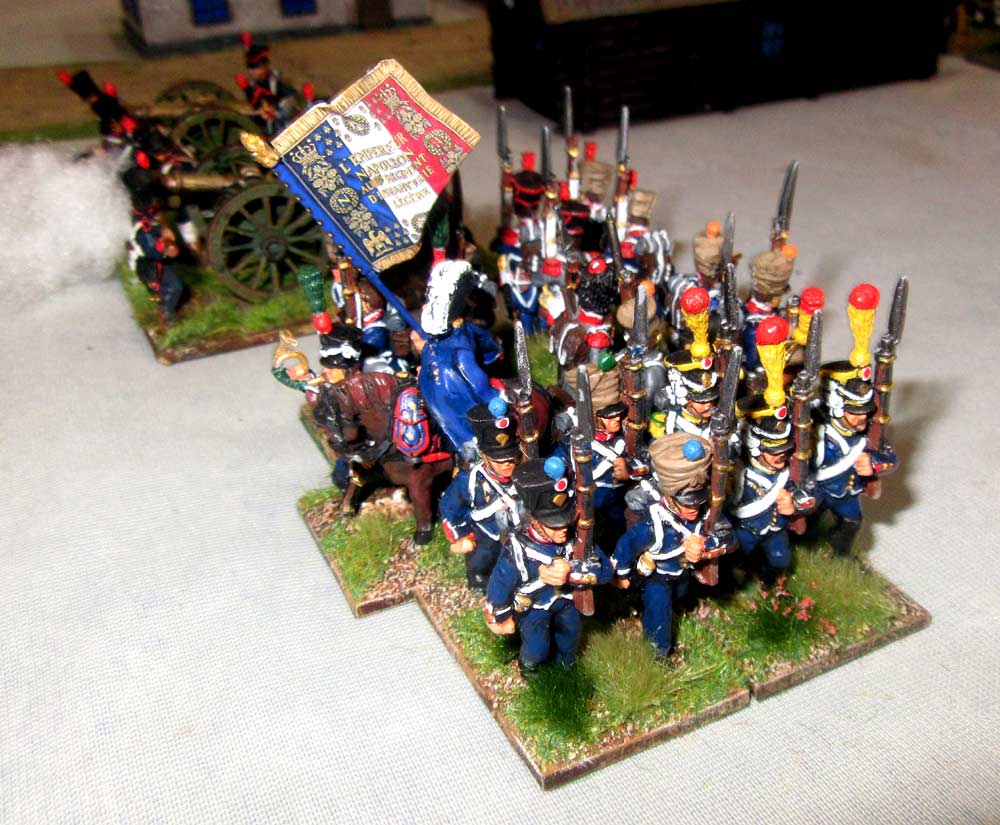 The defenders though, still had a hard time of it. One battalion in square was wiped out by artillery, and then the Hessian cheveauxlegeres were wiped out by musket fire. The Russians had lost too – a cavalry regiment and an infantry battalion, so in terms of casualties the honours were even. In the end though, it was the French light infantry pictured above who would be the last to cross the bridge.
The defenders though, still had a hard time of it. One battalion in square was wiped out by artillery, and then the Hessian cheveauxlegeres were wiped out by musket fire. The Russians had lost too – a cavalry regiment and an infantry battalion, so in terms of casualties the honours were even. In the end though, it was the French light infantry pictured above who would be the last to cross the bridge.  The French infantry drove off the Cossacks, then withdrew in column towards the bridge . The French guns were doing the same, but we worked out that the Russians now couldn’t catch them, as most units were too busy rallying. So, as we were running out of time ourselves, we called the game for the French. It was a hard-fought little game though, and a well-balanced one. I also found I’d forgotten just how straightforward Black Powder games were – and how much fun.
The French infantry drove off the Cossacks, then withdrew in column towards the bridge . The French guns were doing the same, but we worked out that the Russians now couldn’t catch them, as most units were too busy rallying. So, as we were running out of time ourselves, we called the game for the French. It was a hard-fought little game though, and a well-balanced one. I also found I’d forgotten just how straightforward Black Powder games were – and how much fun. 


great AAR Angus….. recently I’ve been researching and playing Soldiers of Napoleon card driven rules –EXCELLENT.
you should check them out
Thanks Peter. I’ve seen good reviews of those rules, and I might give them a look.